
Products & Equipment
Pits & Quarries
Spotlight on Hydraulic Breakers
The newest hammers on the market are more durable, more efficient and easier to service.
February 12, 2013 By Treena Hein
Breaker design continues to evolve, providing those who process Canada’s
aggregates with more choice and control than ever before.
Breaker design continues to evolve, providing those who process Canada’s aggregates with more choice and control than ever before. We’ve checked in with leading breaker manufacturers to bring you the scoop on the newest features that maximize power and reduce the chance of impact or operator error, while increasing comfort and ease of maintenance.
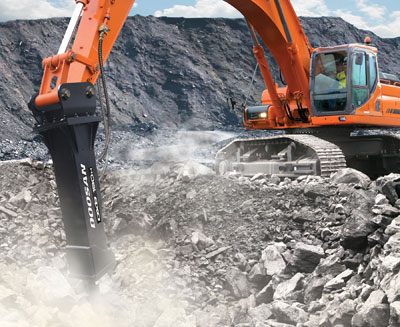 |
|
| With two speeds, the DXB190H breaker frequency can be manually adjusted between low- and high-frequency settings, allowing the operator to match the breaker impact rate to the working conditions for optimized productivity.
|
For example, over the past decade, Atlas Copco Construction Equipment Canada has introduced a number of inter-related breaker design innovations, including increased efficiency in order to provide improved power-to-weight ratios. “This allows operators to install more powerful breakers on carriers than they could before,” says Wayne Ross, vice-president and business line manager of Atlas’s Canadian Construction Tools Division. Introduced in fall 2012, the Atlas SB 702 breaker is the world’s first 700 kg class breaker with solid body housing, which Ross says allows for reduced breaker weight at the same time it eliminates the need for wear items such as side bolts and tie bolts.
Ross notes that the SB 702’s Energy Recovery feature is especially beneficial in tough conditions, allowing the use of unused energy from a single blow in the next blow – rather than that energy being transferred back through the breaker and carrier. “In addition to helping complete your job faster and reducing vibrations, it also has environmental benefits and additional cost savings due to lower fuel consumption,” he explains.
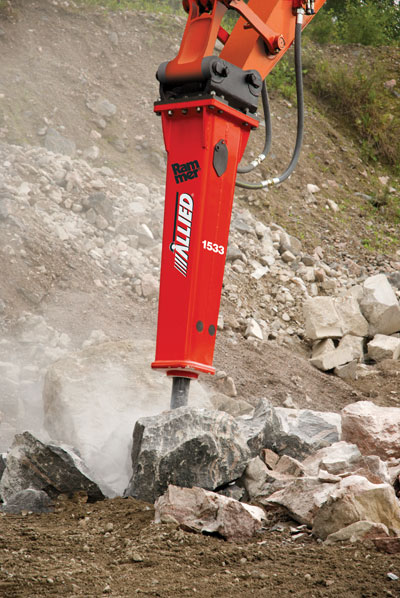 |
|
| Allied offers the new Rammer Model 1533 Mid-Range hammer that features Rammer’s VIDAT (vibration dampened tie rod) system and a slim housing design. |
|
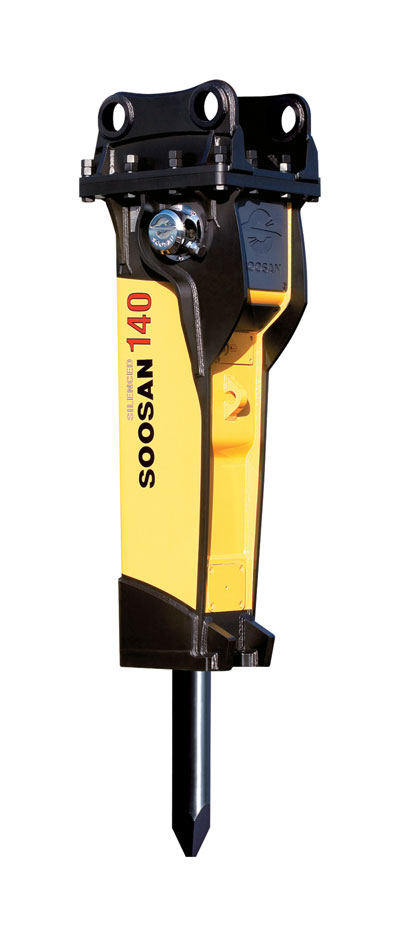 |
|
| The advanced gas and oil percussion mechanism in the Soosan SQ breaker series generates extra power by accumulated gas pressure that ensures reliable performance with a wide range of excavator pump conditions. |
Other SB 702 standard features include AutoControl (an automatic stroke-length switching system), StartSelect (the breaker can be set to automatically start or stop), ContiLube II lubrication system and PowerAdapt. “This last feature is an overload protection system that shuts the breaker down in the event that the carrier’s hydraulic input has not been set to the correct operating parameters of the breaker,” Ross notes, “which prevents catastrophic failure and costly repair.” Atlas breakers also feature a non-return valve that prevents dust and grease from getting sucked into the percussion mechanism of the breaker and the capability to do many routine service functions (such as changing a bushing or retainer bars) on site.
Creighton Rock Drill (CRD) sells Soosan SQ breakers, which the company describes as “a practical innovated hydraulic breaker” that maintains the superior percussion mechanism and easy maintenance of its proven SB series. “The advanced gas and oil percussion mechanism generates extra power by accumulated gas pressure, which ensures a very reliable performance with a wide range of excavator pump conditions,” says CRD media director Darren Crawford. “The IPC & ABH system Integrated Power Control and Anti-Blank Hammering System allows you to choose from three different modes (high frequency, normal power or low frequency with extra power) in accordance with site requirements in a matter of minutes.” SQ breakers also have an improved vibration-dampening system with triple absorbing points, fully enclosed housing, dust protection and auto shut-off.
Convenience is highlighted with the locking device for the tie bolt nut, an auto-lubrication connection and the ability to do exterior nitrogen gas charging and pressure checking.
Creighton also offers OilQuick Automatic Quick Couplers, “allowing hydraulic and mechanical attachments such as breakers to be changed directly from the driver’s cab quickly and easily in just 10 seconds,” notes Crawford. He says these quick coupler systems are regarded as the safest on the market with features like double-hose break valves and a system for constantly readjusting the locking bolts hydraulically.
Doosan Infracore Construction Equipment’s new DXB breaker series also features energy maximization, fewer parts and more convenient maintenance access than previous designs. Long piston strokes maximize impact energy and minimize recoil, and unique features like an energy recovery valve mean that energy generated by piston rebound is used, says Doosan heavy attachment business manager Stephane Giroudon. This can improve performance with hard materials. “Another significant technological advancement is the blank-firing protection designed to protect the hammer from extra wear and tear when an operator misfires,” Giroudon notes.
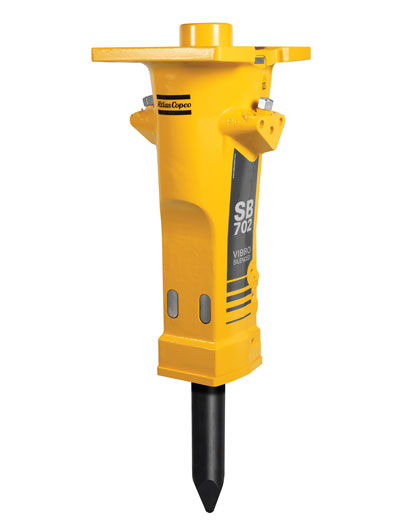 |
|
| The Atlas Copco SB 702 hydraulic breaker is the world’s first 700 kg Class breaker with a solid body housing that eliminates the need for side bolts and tie bolts. |
|
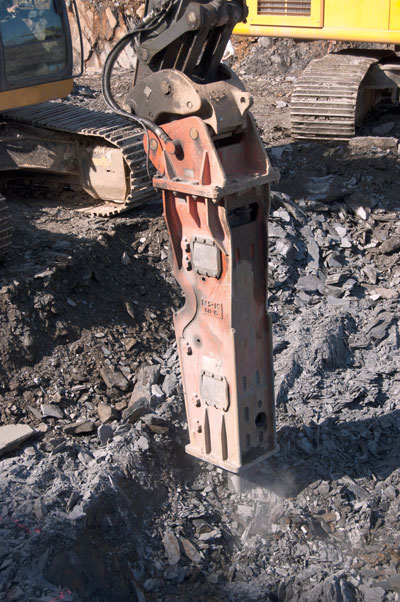 |
|
| The GH line of breakers from NPK includes a long piston stroke, as well as an air line for use in underwater applications.
|
The DXB design also employs a hydraulic cushion at the bottom of the cylinder bore to dampen the speed of the piston. “It protects the hammer against metal-to-metal contact,” says Giroudon. All Doosan breakers are also chuck mount, which means the cradle protects the power cell from damage and reduces noise level. “The suspensions also protect the excavator boom and decrease vibration for enhanced operator comfort,” says Giroudon. The Doosan DXB130H (for excavators from 15 to 28 tonnes) and DXB190H (21 to 31 tonnes) are best suited for concrete and rock demolition. They both include a standard auto-greaser and a variable stroke so the operator can match breaker frequency to material hardness. “This provides greater productivity and reduces the harmful energy transferred back to the excavator,” Giroudon adds.
All NPK breakers are designed with a grease port for automatic and/or manual greasing, as well as a greater piston-to-sleeve bearing area and improved piston-to-seal lubrication, which provides extended seal life. “NPK hydraulic hammers are also designed to eliminate the need for bladder type accumulators that are susceptible to unexpected failure and high maintenance costs,” says marketing manager Steve Kubish. The one-piece design also eliminates the need for mechanical springs and overly heavy mounting brackets. “Our replaceable sleeve design can reduce your body rebuild costs by a factor of five to 10,” Kubish notes. “It’s the industry’s easiest, lowest-cost, body rebuild system.”
The largest in NPK’s newest GH Series line of breakers is the GH-50, which has a 20,000 foot-pound rating. “The GH series feature a compact design and a long piston stroke coupled with greater hydraulic efficiency, enabling small carriers to deliver a high impact, highly productive hammer,” Kubish explains. They also come equipped with an air line for underwater applications. Low operating noise levels are achieved by special cushioning and the bracket design surrounding the hammer, and all medium and large NPK hammers have a shock-absorbing mounting bracket with heavy-duty rubber mounts to absorb shock, recoil and impulse vibration.
Allied Construction now offers two new mid-range hammers – the Rammer 2155 (3000 foot-pound class) and the Rammer 1533 (2000 foot-pound class). “These models both share many new and exciting features,” notes Greg Smith, who is Allied’s marketing communications manager. “These include the VIDAT (vibration dampened tie rod) System and a slim housing design with a replaceable bottom plate made of wear-resistant steel.” The slim housing also offers the operator greater visibility and better accessibility in trenching and demolition operations. Smith also notes that the housing design is sound-suppressed, which increases operator comfort and is important in urban areas where noise restrictions exist.
In addition, the 2155, which is ideal for use on 35,300- to 57,300-pound excavators, has features like stone claws for additional wear resistance and demanding applications. “The 2155 also features Ramdata, a service-indicator system that provides information to operators and maintenance personnel about service intervals, service history and accumulated working history,” says Smith. Additional options on both the 2155 and the 1533 include BreakerLube CML, a carrier-mounted, large capacity automatic lubrication unit that provides lubrication to the demolition tool and bushings, and Ramlube III, an integrated automatic lubrication device mounted inside the hammer housing.
With constant new and innovative efficiencies being created, the hydraulic breaker industry has adapted its technology to meet the demand of the consumer. Now aggregate operations have the ability to choose the breaker that will provide the best result based on the needs of their operation.
Print this page